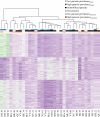Ant behaviour and brain gene expression of defending hosts depend on the ecological success of the intruding social parasite
- PMID: 30967075
- PMCID: PMC6388029
- DOI: 10.1098/rstb.2018.0192
Ant behaviour and brain gene expression of defending hosts depend on the ecological success of the intruding social parasite
Abstract
The geographical mosaic theory of coevolution predicts that species interactions vary between locales. Depending on who leads the coevolutionary arms race, the effectivity of parasite attack or host defence strategies will explain parasite prevalence. Here, we compare behaviour and brain transcriptomes of Temnothorax longispinosus ant workers when defending their nest against an invading social parasite, the slavemaking ant Temnothorax americanus. A full-factorial design allowed us to test whether behaviour and gene expression are linked to parasite pressure on host populations or to the ecological success of parasite populations. Albeit host defences had been shown before to covary with local parasite pressure, we found parasite success to be much more important. Our chemical and behavioural analyses revealed that parasites from high prevalence sites carry lower concentrations of recognition cues and are less often attacked by hosts. This link was further supported by gene expression analysis. Our study reveals that host-parasite interactions are strongly influenced by social parasite strategies, so that variation in parasite prevalence is determined by parasite traits rather than the efficacy of host defence. Gene functions associated with parasite success indicated strong neuronal responses in hosts, including long-term changes in gene regulation, indicating an enduring impact of parasites on host behaviour. This article is part of the theme issue 'The coevolutionary biology of brood parasitism: from mechanism to pattern'.
Keywords: Temnothorax longispinosus; coevolution; parasite prevalence; slavemaking ants; social parasites; transcriptomics.
Conflict of interest statement
We have no competing interests.
Figures




Similar articles
-
Coevolution in host-parasite systems: behavioural strategies of slave-making ants and their hosts.Proc Biol Sci. 2001 Jun 7;268(1472):1139-46. doi: 10.1098/rspb.2001.1627. Proc Biol Sci. 2001. PMID: 11375101 Free PMC article.
-
Collective defence portfolios of ant hosts shift with social parasite pressure.Proc Biol Sci. 2014 Sep 22;281(1791):20140225. doi: 10.1098/rspb.2014.0225. Proc Biol Sci. 2014. PMID: 25100690 Free PMC article.
-
Locally adapted social parasite affects density, social structure, and life history of its ant hosts.Ecology. 2009 May;90(5):1195-206. doi: 10.1890/08-0520.1. Ecology. 2009. PMID: 19537541
-
The coevolutionary dynamics of obligate ant social parasite systems--between prudence and antagonism.Biol Rev Camb Philos Soc. 2005 May;80(2):251-67. doi: 10.1017/s1464793104006669. Biol Rev Camb Philos Soc. 2005. PMID: 15921051 Review.
-
Insect societies fight back: the evolution of defensive traits against social parasites.Philos Trans R Soc Lond B Biol Sci. 2018 Jul 19;373(1751):20170200. doi: 10.1098/rstb.2017.0200. Philos Trans R Soc Lond B Biol Sci. 2018. PMID: 29866913 Free PMC article. Review.
Cited by
-
Mining Amphibian and Insect Transcriptomes for Antimicrobial Peptide Sequences with rAMPage.Antibiotics (Basel). 2022 Jul 15;11(7):952. doi: 10.3390/antibiotics11070952. Antibiotics (Basel). 2022. PMID: 35884206 Free PMC article.
-
Comparative analyses of caste, sex, and developmental stage-specific transcriptomes in two Temnothorax ants.Ecol Evol. 2020 Mar 30;10(10):4193-4203. doi: 10.1002/ece3.6187. eCollection 2020 May. Ecol Evol. 2020. PMID: 32489589 Free PMC article.
-
Differential Gene Expression Correlates with Behavioural Polymorphism during Collective Behaviour in Cockroaches.Animals (Basel). 2022 Sep 8;12(18):2354. doi: 10.3390/ani12182354. Animals (Basel). 2022. PMID: 36139214 Free PMC article.
-
Genome assembly of the temporary socially parasitic spiny ant Polyrhachis lamellidens and its host Camponotus japonicus.DNA Res. 2025 Mar 1;32(2):dsaf005. doi: 10.1093/dnares/dsaf005. DNA Res. 2025. PMID: 40036880 Free PMC article.
-
Task-specific odorant receptor expression in worker antennae indicates that sensory filters regulate division of labor in ants.Commun Biol. 2023 Oct 2;6(1):1004. doi: 10.1038/s42003-023-05273-4. Commun Biol. 2023. PMID: 37783732 Free PMC article.
References
-
- Thompson J. 1999. Specific hypotheses on the geographic mosaic of coevolution. Am. Nat. 153, S1–S14. (10.1086/303208) - DOI
-
- van Valen L. 1973. A new evolutionary law. Evol. Theory 1, 1–30.
Publication types
MeSH terms
Associated data
LinkOut - more resources
Full Text Sources

